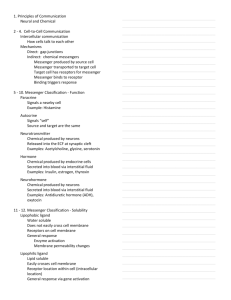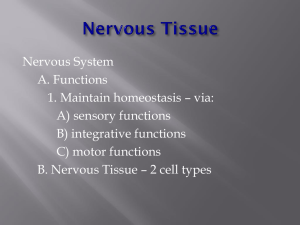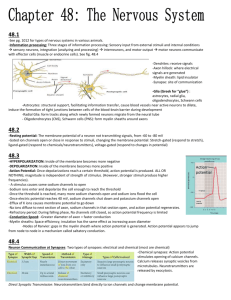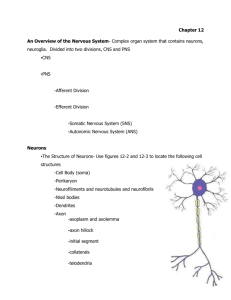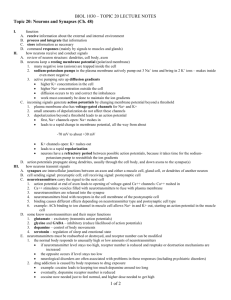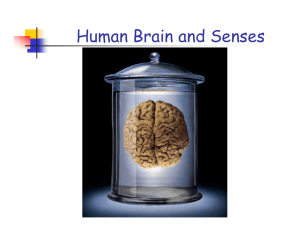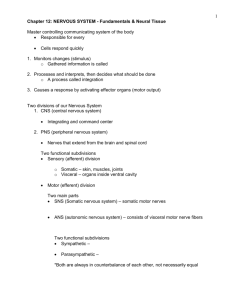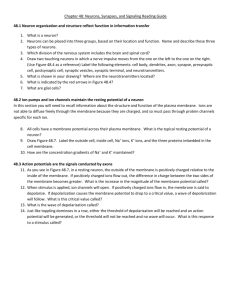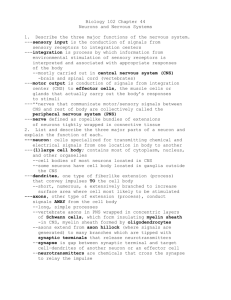26. Resting Potential
advertisement
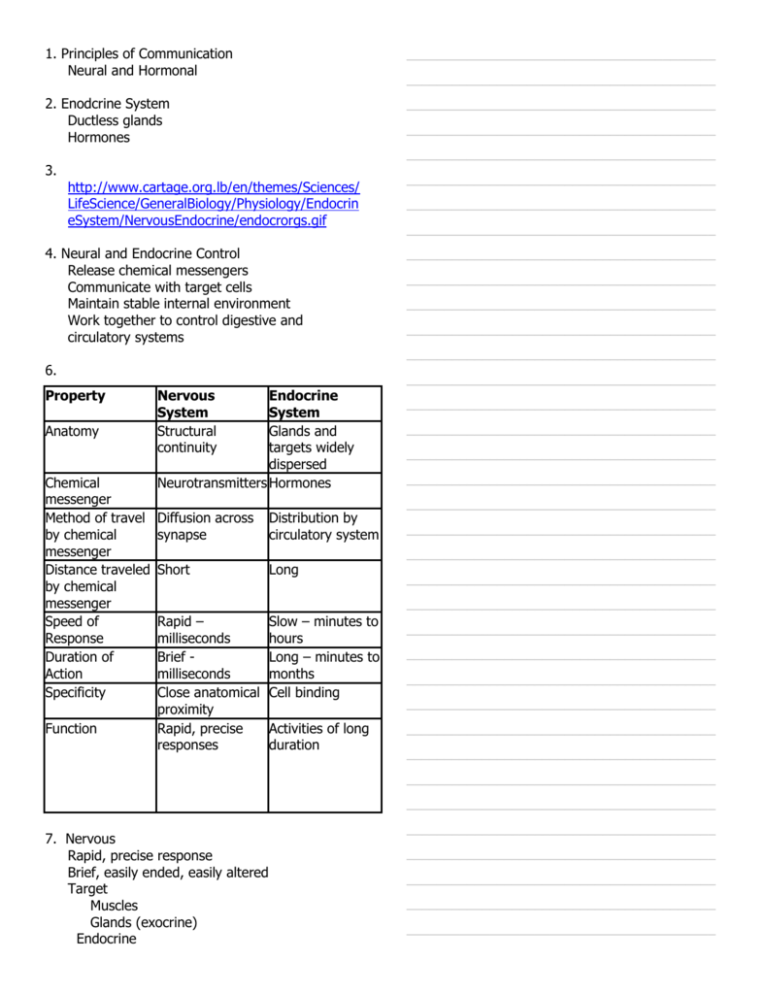
1. Principles of Communication Neural and Hormonal _________________________________________ 2. Enodcrine System Ductless glands Hormones _________________________________________ 3. _________________________________________ _________________________________________ _________________________________________ http://www.cartage.org.lb/en/themes/Sciences/ LifeScience/GeneralBiology/Physiology/Endocrin eSystem/NervousEndocrine/endocrorgs.gif 4. Neural and Endocrine Control Release chemical messengers Communicate with target cells Maintain stable internal environment Work together to control digestive and circulatory systems 6. Property Anatomy Chemical messenger Method of travel by chemical messenger Distance traveled by chemical messenger Speed of Response Duration of Action Specificity Function _________________________________________ _________________________________________ _________________________________________ _________________________________________ _________________________________________ _________________________________________ _________________________________________ _________________________________________ _________________________________________ Nervous System Structural continuity Endocrine System Glands and targets widely dispersed Neurotransmitters Hormones _________________________________________ _________________________________________ _________________________________________ _________________________________________ _________________________________________ Diffusion across synapse Distribution by circulatory system Short Long Rapid – milliseconds Brief milliseconds Close anatomical proximity Rapid, precise responses Slow – minutes to hours Long – minutes to months Cell binding _________________________________________ Activities of long duration _________________________________________ _________________________________________ _________________________________________ _________________________________________ _________________________________________ _________________________________________ _________________________________________ _________________________________________ _________________________________________ _________________________________________ _________________________________________ 7. Nervous Rapid, precise response Brief, easily ended, easily altered Target Muscles Glands (exocrine) Endocrine _________________________________________ _________________________________________ _________________________________________ _________________________________________ _________________________________________ Duration Organic metabolism Water balance Electrolyte balance Growth and development Reproduction 8. Nervous Tissue Neurons Glia Oligodendrocytes Astrocytes Ependymal cells Microglia Schwann cells Satellite cells 9 - 12. Neurons Gather and transmit information by: Responding to stimuli Producing and sending electrochemical impulses Releasing chemical messages http://www.enchantedlearning.com/subjects/an atomy/brain/gifs/Neuron.GIF Cell body Nucleus Synthesis of macromolecules Dendrites Receive & convey information to cell body Axon conduct impulses away from cell body Special transport systems Axoplasmic flow soluble compounds move toward nerve endings rhythmic contractions of axon Axonal transport large, insoluble compounds bidirectional microtubules anterograde transport moves materials away from cell body retrograde transport moves materials toward cell body 13. Functional Classification of Neurons Pseudounipolar: single process sensory neurons Bipolar: two major processes _________________________________________ _________________________________________ _________________________________________ _________________________________________ _________________________________________ _________________________________________ _________________________________________ _________________________________________ _________________________________________ _________________________________________ _________________________________________ _________________________________________ _________________________________________ _________________________________________ _________________________________________ _________________________________________ _________________________________________ _________________________________________ _________________________________________ _________________________________________ _________________________________________ _________________________________________ _________________________________________ _________________________________________ _________________________________________ _________________________________________ _________________________________________ _________________________________________ _________________________________________ _________________________________________ _________________________________________ _________________________________________ _________________________________________ _________________________________________ _________________________________________ _________________________________________ retinal neurons Multipolar: many dendrites and a single axon motor neurons 14. Structural Classification of Neurons Pseudounipolar: single process sensory neurons Bipolar: two major processes retinal neurons Multipolar: many dendrites and a single axon motor neurons 15. Terminology Myelinated Unmyelinated 16. Terminology Ganglia Nuclei Nerves Tracts 17. Nervous System CNS Brain Spinal cord PNS Nerves Ganglia _________________________________________ _________________________________________ _________________________________________ _________________________________________ _________________________________________ _________________________________________ _________________________________________ _________________________________________ _________________________________________ _________________________________________ _________________________________________ _________________________________________ _________________________________________ _________________________________________ _________________________________________ _________________________________________ _________________________________________ _________________________________________ _________________________________________ _________________________________________ _________________________________________ _________________________________________ _________________________________________ _________________________________________ 18. Nervous System Somatic Sensory Information arising from body surface Motor Skeletal muscles Visceral Sensory Information arising viscera Motor Cardiac muscle, smooth muscles, glands _________________________________________ 19. Function of Nervous System Input of sensory information Integration Motor output _________________________________________ 20. Synapse _________________________________________ _________________________________________ _________________________________________ _________________________________________ _________________________________________ _________________________________________ _________________________________________ _________________________________________ _________________________________________ _________________________________________ Specialized junction between a neuron and another cell Chemical Synaptic transmission via neurotransmitters (NT) Electrical synapses Rare in nervous sytem http://www.mirrorservice.org/sites/home.ubalt. edu/ntsbarsh/Business-stat/opre/neurons.gif _________________________________________ _________________________________________ _________________________________________ _________________________________________ _________________________________________ _________________________________________ _________________________________________ _________________________________________ 21. Electrical Synapse Ions move through gap junctions Found in smooth and cardiac muscles, brain, and glial cells 22. Chemical Synapse http://universe-review.ca/I10-40-synapse.jpg 26. Resting Potential 27. Electrical Potential http://regentsprep.org/Regents/physics/phys03 /apotdif/battery.gif 28. Leak Channels Chemical Gradient Concentration High to low Electrical Gradient + and - charges held apart by membrane Potential difference 32. Definitions Transmembrane potential Potential difference Measured across cell membrane Expressed in millivolts (mV) Results from uneven distribution of + and – ions across membrane Resting potential Transmembrane potential under homeostatic conditions 34. Graded Potential. 35 -38. Change in Membrane Potential Passive Leak channels Widespread Always open Active _________________________________________ _________________________________________ _________________________________________ _________________________________________ _________________________________________ _________________________________________ _________________________________________ _________________________________________ _________________________________________ _________________________________________ _________________________________________ _________________________________________ _________________________________________ _________________________________________ _________________________________________ _________________________________________ _________________________________________ _________________________________________ _________________________________________ _________________________________________ _________________________________________ _________________________________________ _________________________________________ _________________________________________ _________________________________________ _________________________________________ _________________________________________ _________________________________________ Gated channels Closed at rest Types Chemical - widespread Voltage - axon (Mechanical) (Temperature) States Closed but able to open Open (activated) Closed and not able to open (inactivated) 39. Definitions Depolarization Transmembrane potential moves toward zero or toward a more positive value Hyperpolarization Transmembrane potential moves away from resting potential and toward a more negative value Repolarization Transmembrane potential moves away from a positive value and toward the resting potential Restoring resting transmembrane potential 41 - 48. Graded Potential Open sodium channels Influx of Na+ Depolarization Open potassium channels Efflux of K+ Hyperpolarization Graded Potential Local changes Limited spread Trigger cell functions Trigger action potential Types Postsynaptic Receptor End-plate Pacemaker 49 - 51. Action Potentials Triggered by graded potentials All-or-none phenomenon Threshold http://www.learner.org/channel/courses/biolog y/archive/images/1968.html _________________________________________ _________________________________________ _________________________________________ _________________________________________ _________________________________________ _________________________________________ _________________________________________ _________________________________________ _________________________________________ _________________________________________ _________________________________________ _________________________________________ _________________________________________ _________________________________________ _________________________________________ _________________________________________ _________________________________________ _________________________________________ _________________________________________ _________________________________________ _________________________________________ _________________________________________ _________________________________________ _________________________________________ _________________________________________ _________________________________________ _________________________________________ _________________________________________ _________________________________________ _________________________________________ _________________________________________ _________________________________________ _________________________________________ _________________________________________ _________________________________________ _________________________________________ 53 – 56. Handout 57 - 59. Action Potential 60 - 63. Refractory Period Absolute Opening of sodium activation gates to closing of inactivation gates Relative Requires greater than normal stimulus Sodium gates closed but able to open _________________________________________ _________________________________________ _________________________________________ _________________________________________ _________________________________________ _________________________________________ _________________________________________ _________________________________________ 64. Comparison of Potentials Graded Potentials Depolarizing or hyperpolarizing No threshold Intensity of stimulus determines polarization Effect on membrane potential decreases with distance No refractory period Most cells Action Potentials Depolarizing Requires depolarization to threshold All-or-none Propagates along entire membrane without change in strength Refractory period Excitable membranes of neurons, muscles _________________________________________ 65. Rate of Impulse Conduction Nerve diameter Myelination Saltatory conduction Multiple sclerosis Factors that influence excitability pH electrolytes _________________________________________ 66. Conduction in an Unmyelinated Axon Axon hillock reaches threshold AP occurs Na+ influx depolarizes adjacent regions to threshold new AP Slow _________________________________________ 67. Conduction in Myelinated Axon Ions can't cross myelin APs occur only at nodes of Ranvier Voltage-gated Na+ channels are present only at nodes Fast Saltatory conduction 68. Propagation of Action Potentials _________________________________________ _________________________________________ _________________________________________ _________________________________________ _________________________________________ _________________________________________ _________________________________________ _________________________________________ _________________________________________ _________________________________________ _________________________________________ _________________________________________ _________________________________________ _________________________________________ _________________________________________ _________________________________________ _________________________________________ _________________________________________ _________________________________________ _________________________________________ _________________________________________ _________________________________________ _________________________________________ _________________________________________ _________________________________________ Action potential is generated at each new membrane patch Continuous - unmyelinated Transmembrane potential becomes positive Local currents established Can only move in one direction, away from stimulus Saltatory- myelinated Local current skips internodes, jumping from node to node 69. Synaptic Terminology Presynaptic Postsynaptic Synaptic knob Synaptic vesicles Synaptic cleft Subsynaptic membrane 71-74. Sequence of Events 1. Action potential reaches synaptic knob 2. Local change in potential opens voltage gated Ca2+ channels 3. Ca2+ enters synaptic knob 4. Release of neurotransmitter from synaptic vesicles by exocytosis 5. Neurotransmitter diffuses across synaptic cleft 6. Neurotransmitter binds to receptors on postsynaptic membrane 7. Binding to receptor triggers opening of chemically-gated ion channels in subsynaptic membrane 71. Neurotransmitters 76. Excitatory Synapses Neurotransmitter binding opens a chemicallygated channel that permits passage of Na+ and K+ Net movement of cations (Na+) into the cell Small depolarization Excitatory postsynaptic potential - EPSP 78. Inhibitory Synapses Neurotransmitter binding opens a chemicallygated channel that permits passage of Cl- or K+ Net movement of anions (Cl-) into the cell or net movement of cations (K+) out of the cell Small hyperpolarization Inhibitory postsynaptic potential - IPSP _________________________________________ _________________________________________ _________________________________________ _________________________________________ _________________________________________ _________________________________________ _________________________________________ _________________________________________ _________________________________________ _________________________________________ _________________________________________ _________________________________________ _________________________________________ _________________________________________ _________________________________________ _________________________________________ _________________________________________ _________________________________________ _________________________________________ _________________________________________ _________________________________________ _________________________________________ _________________________________________ _________________________________________ _________________________________________ _________________________________________ _________________________________________ _________________________________________ _________________________________________ _________________________________________ _________________________________________ _________________________________________ _________________________________________ _________________________________________ _________________________________________ _________________________________________ 80. Synapses Always excitatory or always inhibitory Same neurotransmitter is always released Synaptic delay Removal of neurotransmitters from cleft Diffusion Inactivated by enzymes Taken up into axon terminal _________________________________________ 83. Grand Synaptic Potential GSPS Composite of all ESPSs and ISPSs occurring at approximately the same time _________________________________________ 84. How Is Threshold Reached? Temporal Summation Time A presynaptic neuron firing repeatedly in a very short period of time can bring the postsynaptic membrane to threshold Amount of neurotransmitter released is related to frequency of Aps More NT = more open channels = more ion movement = greater depolarization 87. How Is Threshold Reached? Spatial Summation Different points in space Multiple presynaptic neurons firing simultaneously can bring the postsynaptic membrane to threshold Amount of neurotransmitter released is related to number of presynaptic neurons More NT = more open channels = more ion movement = greater depolarization 92. Information processing 94. http://www.mfi.ku.dk/ppaulev/chapter1/images /n1-6ok.jpg _________________________________________ _________________________________________ _________________________________________ _________________________________________ _________________________________________ _________________________________________ _________________________________________ _________________________________________ _________________________________________ _________________________________________ _________________________________________ _________________________________________ _________________________________________ _________________________________________ _________________________________________ _________________________________________ _________________________________________ _________________________________________ _________________________________________ _________________________________________ _________________________________________ _________________________________________ _________________________________________ _________________________________________ _________________________________________ _________________________________________ _________________________________________ _________________________________________ _________________________________________ _________________________________________ _________________________________________ _________________________________________ _________________________________________ _________________________________________ _________________________________________ _________________________________________ _________________________________________ _________________________________________ _________________________________________ _________________________________________ _________________________________________ _________________________________________ _________________________________________

